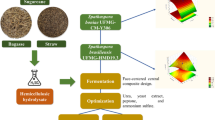Summary
The conversion of nutrient-supplemented and non-supplemented acid-extracts from peat to biomass of the acid-resistant fungus Scytalidium acidophilum is described. Yeast extract and several inorganic salts were tested as nutrient supplement to the peat extract in shake-flask experiments and in an agitated and aerated fermentor. The best results were obtained in the fermentor, with 0.3% yeast extract, which produced 6.2 g dry biomass/1 with a yield of 41% and an efficiency of 30%, at 200 rpm and 1.75 vvm in 8 days. Although higher agitation speeds appeared detrimental to the mycelial physiology, it was detected that the dissolved oxygen concentration at 200 rpm could limit the growth of S. acidophilum if higher biomass concentrations are obtained. The potential for utilizing the residual fermentation medium as a plant liquid fertilizer is reported.
Similar content being viewed by others
References
Boa JM, LeDuy A (1983) Acidophilic fungus SCP from peat hydrolysate. Can J Ch Eng 60:532–537
Gould WD, Fujikawa JH, Cook FD (1974) A soil fungus tolerant to extreme acidity and high salt concentrations. Can J Microbiol 20:1023–1027
Harrison VF, Gow WA, Ivarson KC (1966) Leaching of uranium from Elliot Lake ore in the presence of bacteria. Can Min J 87:64–67
Hofsten BV, Ryden AL (1975) Submerged cultivation of a thermotolerant Basidiomycete on cereal fluors and other substrates. Biotechnol Bioeng 27:1183–1197
Ivarson KC, Morita H (1982) Single-cell protein production by the acid-tolerant fungus Scytalidium acidophilum from acid hydrolysates of waste paper. Appl Environ Microbiol 43:643–647
Kruglov VP, Mayakova EF, Rakovsky VE (1975) Peat as a raw material for obtaining fodder and biologically active preparations. In: Proc 5th Int Peat Congress, vol 3 Poznan, Poland. 59–62
LeDuy A, Kosaric N, Zajic E (1975) Correction factor for anthrone carbohydrate in coloured wastewater samples. Proc 10th Can Water Poll Res Symp 126–131
Martin AM, White MD (1984) Adaptation of the acid-tolerant fungus Scytalidium acidophilum to growth in peat extracts. Proc Third Europ Congress on Biotechnol, Vol. 2, Verlag Chemie, Weinheim 571–576
Martin AM, White MD (1985) Growth of the acid-tolerant fungus Scytalidium acidophilum as a potential source of single-cell protein. J Food Sci 50:197–200
Morris DL (1948) Quantitative determination of carbohydrates with Dreywood's anthrone reagent. Science 107:254–255
Sigler L, Carmichael JW (1974) A new acidophilic Scytalidium. Can J Microbiol 20:267–269
Starkey RL, Waksman SA (1943) Fungi tolerant to extreme acidity and high concentrations of copper sulphate. J Bacteriol 45:509–519
Author information
Authors and Affiliations
Rights and permissions
About this article
Cite this article
Martin, A.M., White, M.D. Studies on the production of Scytalidium acidophilum biomass. Appl Microbiol Biotechnol 24, 84–88 (1986). https://doi.org/10.1007/BF00266291
Received:
Revised:
Issue Date:
DOI: https://doi.org/10.1007/BF00266291




